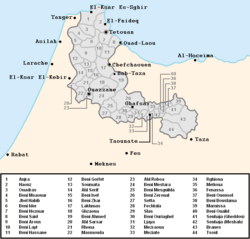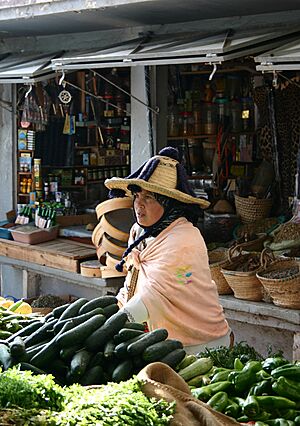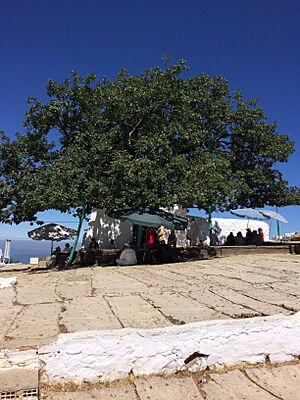Jebala people facts for kids
| جبالة | |
|---|---|

Map of territories inhabited by Jebala in Northern Morocco
|
|
| Total population | |
| 1,284,000 | |
| Regions with significant populations | |
| Northern Morocco, mostly concentrated in north-west Morocco and Rif | |
| Languages | |
| Jebli Arabic | |
| Religion | |
| Sunni Islam |
The Jebala (Moroccan Arabic: جبالة, romanized: Jbāla) are a group of tribes living in northwest Morocco. Their home is in the western part of the Rif mountains. This area stretches from the town of Targuist towards the west.
About 1,284,000 Jebala people live here. They are made up of over 44 Arab tribes. These are now called "rural communes." Close by are 9 other tribes called the Ghomaras. They live between the mountains north of Chefchaouen and the Mediterranean Sea.
The Jebala region has high mountains, hills, and flat areas. The climate is rainy, which affects how houses are built. It also influences their farming methods. These things, along with their culture, make the Jebala unique. They are different from their Berber neighbors in the eastern Rif Mountains. These neighbors are called Riafa or Rwafa.
Today, most Jebala people do not identify with a specific tribe. They are often called Chamalis. This is the same name used for Arabs in cities in northwest Morocco. "Chamalis" simply means "Northerners" in Arabic. Many Jebala now live in cities. These include Tangier, Tetouan, Ksar Kebir, Ksar es Sghir, Larache, Ouazzane, Asilah, Chefchaouen, and Taounate.
Contents
What Does Jebala Mean?
The word Jbala comes from the Arabic word جبل, Jbel. This word means mountain. So, Jbala means mountain people. A man or boy from this group is called a Jebli. A woman or girl is called a Jebliya.
Where Do the Jebala Come From?
The Jebala people have a mixed background. There are more than 44 Arab Jebala tribes. There are also 9 Arabized Ghomara tribes. The Ghomaras started speaking Arabic between the 10th and 15th centuries. This happened because of Arab people from cities in Northern Morocco and Al-Andalus. Their land was also on a main travel route between these places.
A Look at Jebala History
We don't know much about the very early history of this region. But the history of the Jebala people is well-known since early Islamic times. The early Islamic history of the Rif region includes the Arab Nekor Emirate. This was started by the Arab Salih ibn Mansur. He came from the Himyarite in Yemen. Many Arab tribes settled in the Rif during this time.
Jebala Culture
Language of the Jebala
The Arabic language spoken by the Jebala is called Chamali Arabic. It is part of a group of dialects called Pre-Hilali or Non-Hilali Arabic. Some people also call it ‘mountaineer Arabic’. This name suggests that Arabic came to North Africa long before the Bani Hilal tribe arrived. That tribe migrated in the 12th-13th centuries.
The Pre-Hilali group includes the Jebli dialect. It also includes dialects spoken in other North African cities. The Ghomaras were among the first Imazighen (Berbers) to start speaking Arabic. This was likely because they lived near an old trade route. This route connected cities like Fes with Mediterranean ports. Many of these ports were in al-Andalus.
Jebala Clothing
Traditional clothing for Jebala women includes "mendils." These are shawls made from cotton or wool. They are usually rectangular and woven with white and red stripes. Women wrap them around their waist to make skirts. They also use them as shawls or to carry babies and goods.
The traditional outer clothing for men is the djellaba. This is a one-piece cloak made of cotton or wool. It has a pointed hood. In the Jebala region, the wool is often undyed. So, dark brown and off-white colors are common. White djellabas are worn for religious festivals.
The Jebala people like pointed-toed leather slippers. Light brown, yellow, and white are the most common colors. Reed hats are another traditional part of Jebala dress. Both men and women wear them. Women's hats often have woven wool tassels and ropes. These are usually in black, white, and red.
Oral Traditions and Music
The oral poetry of the Jebala is known as ayta jabaliya. A famous artist named Mohamed Laroussi helped make it popular. He was a talented poet, musician, and singer from the Jebala region. He was called ‘the artist of the Jbala’ or ‘beloved by all Jbala people’. His songs have been available for decades. They are found on LPs, tapes, CDs, and MP3s. His concerts have also been shown on Moroccan television since the 1960s. You can find his music and videos online today.
There are three different types of ayta jabaliya. These are ʿayta jebliya’, ʿayyuʿ, and ughniya’. The Jebala people believe their culture comes from Moorish Andalusian Spain. This was a time when Muslims ruled parts of Spain (711–1492). Jebala musicians often tell stories about Musa ibn Nusayr. He was a famous conqueror of Spain. They also talk about the sad end of Islamic rule there. This shows a strong link between the Jebala region and Andalusia even now.
Jebala Poetry
Traditional Jebli poetry is almost always spoken aloud. It usually doesn't have a known author. It's rare for someone to claim they wrote a specific song or poem. Poetry is often made up on the spot. But sometimes, it is memorized and then performed.
Jebli poetry is always connected to music and performance. Because of this, it is not usually called ‘poetry’ or shi’r (شعر). Instead, it is called klam (كلام), which means ‘lyrics’. Music, or lhan (لحن), is very important. The music style helps identify the type of song.
A traditional Jebli poet connects their words to a specific tune. They choose from melodies common in their tradition. Then, they try to organize their poetry into beyt-s (بيت), or four-line verses. A beyt usually has four short lines. Each line has 6-8 syllables. The second line often rhymes with the fourth one. If the beyt is part of an ayta jebliya or ughniya, the poet adds a lazima (لازمة), or a repeating part. This helps hold the text together.
Jebala Music
Music and dancing are very important in Jebala culture. The Jebala play the "Ghayta," which is like a clarinet. They also play the tbul, which is a drum. Dancing is usually performed by boys.
Differences in Culture and Economy
The Jebala people have a different culture from the Rifians. For example, the Jebala use oxen for ploughing. They yoke the oxen by their horns. Rifians, however, use cows yoked by their necks.
For their house roofs, Jebala people use corrugated iron or thatch. Rifians use dried clay. In areas with more rainfall, like the Atlantic coast, Jebala prefer pointed roofs. In the Rif, where it rains less, flat roofs are common.
Jebala villages have houses built close together. Rifians traditionally have houses spread out. Their homes are usually at least 300 meters apart. Another difference is that many Jebala now identify as Chamalis. This is like the Arabs in cities in northwest Morocco. Chamalis simply means Northerners in Arabic.
Special Technologies
The Rif region is mountainous. But its closeness to the Straits of Gibraltar made it important for trade. It was a route to the Mediterranean world, especially to al-Andalus. This affected the people living there. They adopted Arabic early and had many literate people. Cities nearby also influenced their culture and economy.
These factors led to some unique inventions. They might seem small, but they were special for the Maghreb region. For example, they built houses with sloping thatched roofs. These are similar to roofs found in southern Andalusia. They also had a special way of yoking horned cattle. The yoke was placed behind the horns. This system is only known in a few parts of Europe.
Other special technologies include haystacks made without a base. Instead, they are held together by cords and stones. They also built granaries raised on pillars. This design exists in other parts of the world, like the Spanish Cantabrian Mountains. They had a hand flour mill that used a connecting rod-crank. This turned a back-and-forth motion into a spinning one.
They also used a water mill with a vertical shed. This was used only in a small area near Gibraltar. It was different from the ramp mill used elsewhere in the country. They had an oil press with double side screws. It was small and easy to move. Finally, they used a piston-type butter-churn. This churned butter with an up-and-down motion instead of a side-to-side one.
These unique technologies likely survived because the area was protected. It is in the heart of the Rif mountains, shielded by the sea. It was also protected from southern influences by a large mountain range. This isolation, along with four centuries of limited contact with Spain, helped preserve these traditions. The region is a special place where different natural factors meet. It combines mountains, sea, and land routes.
Plants, Animals, and Farming
The Rif is one of the most populated mountain ranges in the Mediterranean area. The western and central parts are rich in different kinds of plants and animals. It's like a safe place for many rare crops. For example, they still grow rye, small spelt, and sorghum. Sorghum is their main spring cereal instead of corn.
There is also a huge variety of fruit trees. There are over a hundred types of fig trees alone. People in this region have also grown grapes for a long time. Today, they still make grape syrup called samit. This syrup is sometimes lightly fermented, which means it contains alcohol. This can cause discussions about whether it's allowed in Islamic beliefs.
Olive trees are very important. They cover 77% of the land used for planting trees. This area is also known for special kinds of honey. These include carob and arbutus honey. Wild plants are also used a lot for food. However, flax and mulberry trees have disappeared. With them, many local crafts have also been lost.
Local people have found new ways to improve their traditional products. These products are valuable today. There is a strong demand for organic food. People also want food with special health benefits. This is based on old traditions and local plant types. However, it is hard to pass this knowledge to younger generations.
Religious Traditions and Pilgrimages
The Jebala people are Muslims. But their religious practices include many local traditions. They often go on a minor or local pilgrimage called ‘ziyara’ (زيارة). These pilgrimages are usually made to the shrines of local saints.
The Jebala region is known as the "land of saints." This is because there are many sacred places scattered throughout the area. Each Jebli tribe has at least one Sufi lodge, or ‘zawiya’ (زاوية). This lodge is next to its saint's shrine, or ‘darih’ (ضريح). Almost all zawiya-s have a special season or ‘mawsem’ (موسم). These are large gatherings of faithful Muslims. They happen on specific dates. For example, the Bni Zerwal tribe has seven such places. Some saints, like Moulay Bou Shta el-Khammar and Sidi Allal el-Hajj, are more famous than others.
One saint is highly respected by the Jebala and all of Morocco. This is Moulay Abdessalam Ben Mshish. He was from the Jebala region. Moulay Abdessalam is called the quṭb al-Maġrib al-aqṣa. This means ‘the spiritual leader of the far Maghreb’. In Islam, a qutb is a very important spiritual symbol for a certain time. In Morocco, qutbs are seen as spiritual leaders for other saints.
This idea is linked to the Shadhiliya brotherhood. This is a powerful Sufi group in Morocco and North Africa. Going on pilgrimage to the shrine of Moulay Abdessalam ben Mshish has been very important for the Jebli people for centuries. The pilgrimage season usually starts around the 15th of Shaaban in the Islamic calendar. At this time, pilgrims come from all over the Jebala land. They also come from other parts of Morocco. They gather at Mount Alam. This gathering is called lamma (لامة). People sing religious hymns and prayers. Then, it turns into picnics and family get-togethers. During these gatherings, people often share short sung poems called ayyu-s.
List of Jebala Tribes
The Jbala people are made up of more than 50 tribes, including the Ghomara:
- Beni Anjra
- Beni Haouz
- Beni Ouadras
- Beni Msaouar
- Beni Jbel Habib
- Beni Ider
- Beni Hozmar
- Beni Said
- Beni Dijo
- Beni Arous
- Beni Layt
- Beni Hassane
- Beni Gorfet
- Beni Soumata
- Beni Ahl Serif
- Beni Isef
- Beni Zkar
- Beni Lakhmas
- Beni Ghzaoua
- Beni Ahmed
- Beni Ahl Sarsar
- Beni Rhona
- Beni Masmouda
- Beni Ahl Roboa
- Beni Mestara
- Beni Mesguilda
- Beni Zeroual
- Beni Setta
- Beni Fechtala
- Beni Slas
- Beni Ouriaghel
- Beni Ljaya
- Beni Mezraoua
- Beni Meziate
- Beni Rghioua
- Beni Metioua
- Beni Fenassa
- Beni Ouensel
- Beni Bouslama
- Beni Marnissa
- Beni Oualid
- Beni Senhaja-Gheddou
- Beni Senhaja-Mesbah
- Beni Branes
- Beni Tsoul
- Beni Targuist
- Beni Ketema
- Beni Gmil
- Beni Rezin
- Beni Khalid
- Beni Zejel
- Beni Ziat
- Beni Bouzra
- Beni Selman
- Beni Mansour
- Beni Smih
See also




